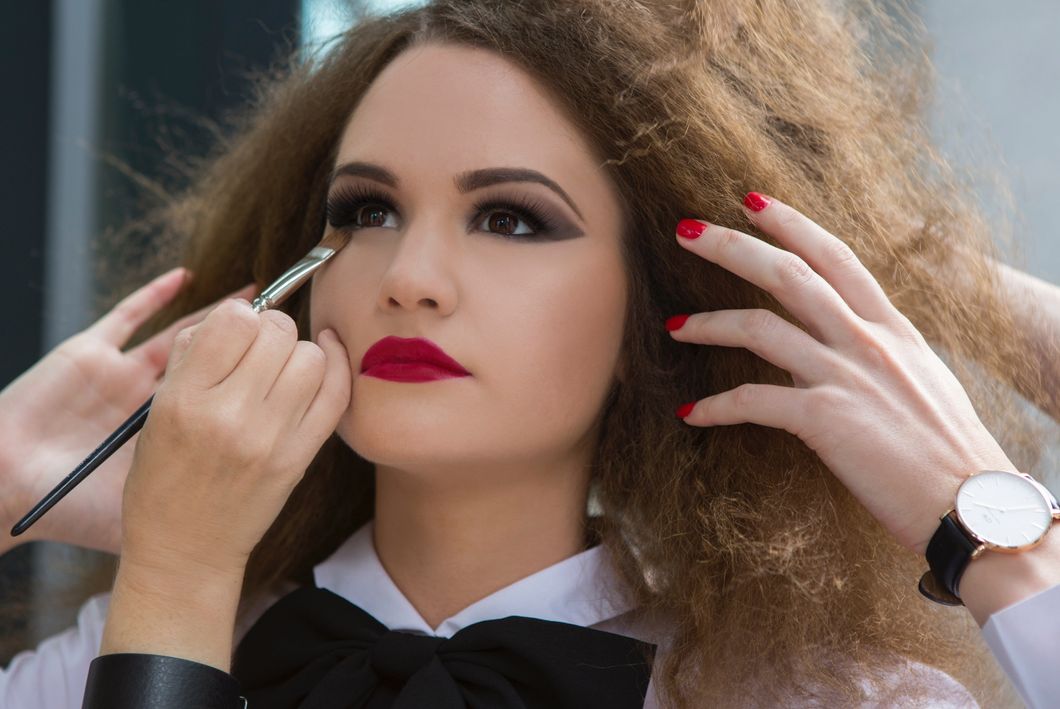As the rainy season is upon us, I'm sure you've come to despise the skyrocketing humidity levels that practically melt and obstruct the makeup you work so hard on perfecting. Stop letting the humid weather decide what your makeup looks like and consider these tips that will alleviate oily spots and keep your makeup fresh for longer.
1. Apply translucent powder before you prime.
After moisturizing the face, use a powder brush to apply a light coat of any translucent or color matching powder you have to all areas of the face and neck that you will be applying foundation to. It is important to press the powder into your face by patting the brush or sponge instead of swiping across the skin in order to cover all areas evenly and prevent blotchiness. Let your powder set for a couple of minutes then apply your preferred primer or base product over the set powder. Using a setting powder as one of your bases before foundation will provide your first defense against humidity, relieving you from extra oils or sweat that can accumulate from the damp air quality.
2. Use less foundation and more powder products.
Although it seems logical to apply more foundation than usual if you want to sustain enough coverage after blotting and wiping away excess oils throughout the day, your best bet is to use as little foundation as possible. Use enough foundation to cover your troubled areas and blend it in with a beauty sponge or foundation brush until a thin coat is layered over the areas you primed. Immediately follow the application of your foundation with your favorite powder products such as bronzer, contour or blush. Layering powder products over fresh foundation will help set the base over the areas where you apply multiple products so that they won't rub or sweat off easily. Make sure to prevent swiping on powders to avoid blotchiness and instead pat the product into the wet foundation firmly.
3. Bake three areas with setting powder.
After you have applied foundation, contoured and added blush, dip one side of your beauty blender into your favorite setting powder and massage the product onto your hand or another area to push the powder into the sponge. This will prevent blotchy powder marks on your beauty blender and face, allowing you to pick up an even coat of powder to begin baking. To locate the border you will apply powder to, smile with your mouth closed until you see the lines below your cheek bones. Apply a generous amount of setting powder across that line to define and lift your cheekbones while setting the foundation that is not already coated with powder products. Proceed by applying a generous amount of powder beneath the eyes and on the lower half of your forehead. Let the powder sit for five minutes in each area before dusting it off lightly with any clean brush.
4. Apply setting spray at the beginning, middle and end of your routine.
If you feel like your setting spray doesn't do its job on humid days, it's because you aren't applying enough of it. You should apply an even first coat of setting spray right after you apply your foundation in order to help powder products absorb and adhere to your base. After you finish applying the rest of your powder products, mist another layer of setting spray before you bake your face so that the matte finish of the powder can lock onto the foundation. Your last coat of setting spray should be applied once your makeup is complete. To lock in the benefits of your setting spray, you can either mist a beauty blender and pat the product in or mist the spray directly on your face and pat it in with a sponge or clean brush.
5. Use your makeup sponge correctly.
If you don't have a makeup sponge yet, I recommend purchasing one from your local Sephora or CVS. You should use a wet beauty sponge after each step in your makeup routine so that every product (powder or not) is blended together and pushed into the skin. Using a beauty sponge to blend bronzer, blush, highlighter, setting spray and even setting powder into your base foundation will not only provide you with a more airbrushed look, but it will help melt each product into one another so that the oils and sweat caused by humidity won't make your makeup patchy or runny.
It is important to consider your skin type and alter any of these suggestions when attempting new makeup methods in order to conform to your face's natural oil production levels. If you want to build on a full or natural face of makeup without worrying about rain or humidity, try these tips the next time the weather is unforgiving.



 StableDiffusion
StableDiffusion StableDiffusion
StableDiffusion StableDiffusion
StableDiffusion Photo by
Photo by  Photo by
Photo by  Photo by
Photo by 
 Photo by
Photo by  Photo by
Photo by  Photo by
Photo by  Photo by
Photo by  Photo by
Photo by 












